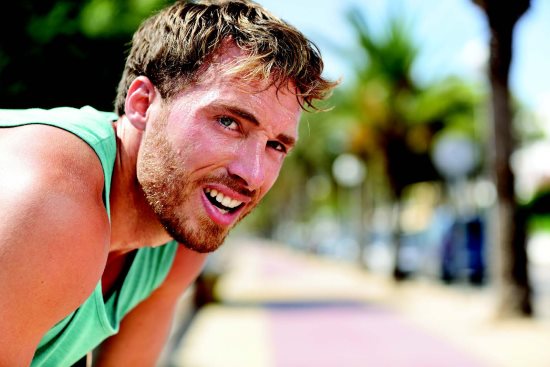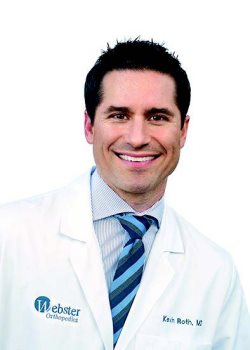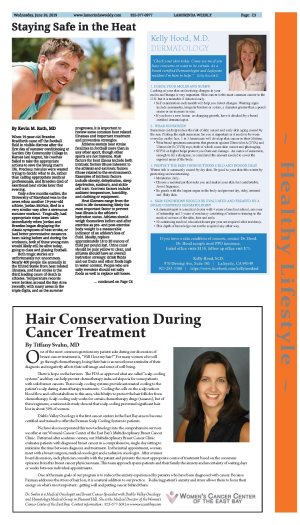| | Published June 26th, 2019
| Staying Safe in the Heat
| | | By Kevin M. Roth, MD |  | | |
When 19-year-old Braeden Bradforth came off the football field in visible distress after the first day of summer conditioning at Garden City Community College in Kansas last August, his coaches failed to take the appropriate actions to save the young man's life. Precious minutes were wasted trying to decide what to do, rather than calling appropriate medical professionals, and Braeden died of exertional heat stroke later that evening.
 Only a few months earlier, the University of Maryland was in the news when another 19-year-old athlete, Jordan McNair, died in a very similar way after a strenuous summer workout. Tragically, had appropriate steps been taken immediately when Jordan and Braeden began displaying the classic symptoms of heat stroke, or had better preventative measures been taking before and during the workouts, both of these young men would likely still be alive today, going to class and playing football.
Only a few months earlier, the University of Maryland was in the news when another 19-year-old athlete, Jordan McNair, died in a very similar way after a strenuous summer workout. Tragically, had appropriate steps been taken immediately when Jordan and Braeden began displaying the classic symptoms of heat stroke, or had better preventative measures been taking before and during the workouts, both of these young men would likely still be alive today, going to class and playing football.
 Both tragic stories are unfortunately not uncommon. Nearly 400 people die annually in the United States from heat related illnesses, and heat stroke is the third leading cause of death in athletes. Temperature records were broken around the Bay Area recently, with many areas in the triple digits, and as the summer progresses, it is important to review some common heat related illnesses and important treatment and prevention strategies.
Both tragic stories are unfortunately not uncommon. Nearly 400 people die annually in the United States from heat related illnesses, and heat stroke is the third leading cause of death in athletes. Temperature records were broken around the Bay Area recently, with many areas in the triple digits, and as the summer progresses, it is important to review some common heat related illnesses and important treatment and prevention strategies.
 Athletes sustain heat stroke fatalities in football more than in any other sport, though other sports are not immune. Risk factors for heat illness include both intrinsic factors (those inherent to the athlete) and extrinsic factors (those related to the environment). Examples of intrinsic factors include obesity, dehydration, sleep deprivation, sunburn, and sickle cell trait. Extrinsic factors include ambient temperature, humidity, and clothing or equipment.
Athletes sustain heat stroke fatalities in football more than in any other sport, though other sports are not immune. Risk factors for heat illness include both intrinsic factors (those inherent to the athlete) and extrinsic factors (those related to the environment). Examples of intrinsic factors include obesity, dehydration, sleep deprivation, sunburn, and sickle cell trait. Extrinsic factors include ambient temperature, humidity, and clothing or equipment.
 Heat illnesses range from the mild to life threatening; likely the most important factor to prevent heat illness is the athlete's hydration status. Athletes should weigh themselves before and after exercise as pre- and post-exercise body weight is a measurable indicator of an athlete's loss of fluid. Ideally, replace approximately 16 to 20 ounces of fluid per pound lost. Urine color should be pale yellow to clear, and athletes should have an overall hydration strategy: drink fluids and eat fruits and other foods high in water content. People who are salty sweaters should eat salty foods as well to replace salt losses.
Heat illnesses range from the mild to life threatening; likely the most important factor to prevent heat illness is the athlete's hydration status. Athletes should weigh themselves before and after exercise as pre- and post-exercise body weight is a measurable indicator of an athlete's loss of fluid. Ideally, replace approximately 16 to 20 ounces of fluid per pound lost. Urine color should be pale yellow to clear, and athletes should have an overall hydration strategy: drink fluids and eat fruits and other foods high in water content. People who are salty sweaters should eat salty foods as well to replace salt losses.
 When replacing fluids, cold drinks are more effective than room temperature drinks. Liquids with electrolytes and sugar, such as sports drinks, improve the ability for water to enter the body's cells and hence promote rehydration. By contrast, plain water consumption during rapid sweat losses over an extended period of time causes an overall loss of salt from the body and can cause low sodium levels, a dangerous condition called "hyponatremia". Athletes exercising in the heat in excess of 60 minutes should consume sports drinks and water instead of just plain water.
When replacing fluids, cold drinks are more effective than room temperature drinks. Liquids with electrolytes and sugar, such as sports drinks, improve the ability for water to enter the body's cells and hence promote rehydration. By contrast, plain water consumption during rapid sweat losses over an extended period of time causes an overall loss of salt from the body and can cause low sodium levels, a dangerous condition called "hyponatremia". Athletes exercising in the heat in excess of 60 minutes should consume sports drinks and water instead of just plain water.
 Prevention
Prevention
 Education also plays a critical role in prevention of heat-related illness. Athletes, coaches, parents and athletic trainers all play an important role and, if recognized early, simple measures can be taken that may prove lifesaving. Obese athletes should be monitored more closely, as their risks are greater. It is important to pay attention to clothing and equipment that can decrease the body's ability to cool itself, such as football pads.
Education also plays a critical role in prevention of heat-related illness. Athletes, coaches, parents and athletic trainers all play an important role and, if recognized early, simple measures can be taken that may prove lifesaving. Obese athletes should be monitored more closely, as their risks are greater. It is important to pay attention to clothing and equipment that can decrease the body's ability to cool itself, such as football pads.
 A universally recognized strategy to prevent heat illness is to allow athletes to build a tolerance to exercising in the heat, a process called "acclimatization." This process can take 1-2 weeks and may take slightly longer for adolescents. The athlete should be exposed to gradually increasing levels of exertion, equipment wear, and time in the heat. As summer workouts start up for football and other sports, this need for acclimatization is a crucial, though often overlooked, strategy to minimize risk of heat illnesses.
A universally recognized strategy to prevent heat illness is to allow athletes to build a tolerance to exercising in the heat, a process called "acclimatization." This process can take 1-2 weeks and may take slightly longer for adolescents. The athlete should be exposed to gradually increasing levels of exertion, equipment wear, and time in the heat. As summer workouts start up for football and other sports, this need for acclimatization is a crucial, though often overlooked, strategy to minimize risk of heat illnesses.
 Ideally, summer football workouts should start with limited time in the heat, wearing loose fitting clothing, and without pads. Gradually, stressors should be added so that the athlete's body can become accustomed, such as increasing the exercise intensity, or duration. Eventually, helmets might be added, and finally full pads. All athletes should be given frequent breaks, provided shade and encouraged to remove protective equipment during breaks to cool off.
Ideally, summer football workouts should start with limited time in the heat, wearing loose fitting clothing, and without pads. Gradually, stressors should be added so that the athlete's body can become accustomed, such as increasing the exercise intensity, or duration. Eventually, helmets might be added, and finally full pads. All athletes should be given frequent breaks, provided shade and encouraged to remove protective equipment during breaks to cool off.
 Treatment
Treatment
 The most severe form of heat illness is heat stroke and is a life-threatening medical emergency. Emergency Medical Services (9-1-1) should be called immediately. Rapid cooling of the body in an ice bath is the gold standard of treatment. Once the athlete shows signs of heat stroke, the clock is ticking, and the athlete has a much better chance of survival if these measures are taken within 30-60 minutes. For this reason, a high index of suspicion, and adequate preparation and awareness of the condition is crucial to be able to mobilize and act appropriately when the time comes.
The most severe form of heat illness is heat stroke and is a life-threatening medical emergency. Emergency Medical Services (9-1-1) should be called immediately. Rapid cooling of the body in an ice bath is the gold standard of treatment. Once the athlete shows signs of heat stroke, the clock is ticking, and the athlete has a much better chance of survival if these measures are taken within 30-60 minutes. For this reason, a high index of suspicion, and adequate preparation and awareness of the condition is crucial to be able to mobilize and act appropriately when the time comes.
 As the days get hotter this summer, be sure to take frequent breaks, drink plenty of electrolyte rich liquids, and call for professional help when necessary. Have fun and stay safe out there!
As the days get hotter this summer, be sure to take frequent breaks, drink plenty of electrolyte rich liquids, and call for professional help when necessary. Have fun and stay safe out there!
 Symptoms of heat exhaustion
Symptoms of heat exhaustion
 Signs and symptoms of heat exhaustion may develop suddenly or over time, especially with prolonged periods of exercise. Possible heat exhaustion signs and symptoms include:
Signs and symptoms of heat exhaustion may develop suddenly or over time, especially with prolonged periods of exercise. Possible heat exhaustion signs and symptoms include:
 � Cool, moist skin with goose bumps when
� Cool, moist skin with goose bumps when
 in the heat
in the heat
 � Heavy sweating
� Heavy sweating
 � Faintness
� Faintness
 � Dizziness
� Dizziness
 � Fatigue
� Fatigue
 � Weak, rapid pulse
� Weak, rapid pulse
 � Low blood pressure upon standing
� Low blood pressure upon standing
 � Muscle cramps
� Muscle cramps
 � Nausea
� Nausea
 � Headache
� Headache
 Source: www.mayoclinic.com
Source: www.mayoclinic.com |
 | | Dr. Roth is a Board-Certified fellowship trained orthopedic surgeon specializing in Sports Medicine and injuries that occur in active people of all ages. He sees patients out of his Oakland and Dublin offices with Webster Orthopedics. He is the Head Team Physician for Contra Costa Community College and a Consultant Team Physician for Campolindo High School. Visit him at www.KevinRothMD.com or call 800-943-8099 for an appointment. Dr. Roth grew up in Moraga and currently lives in Orinda with his wife and 6-year-old twins. | | | | | | | | | | | |





